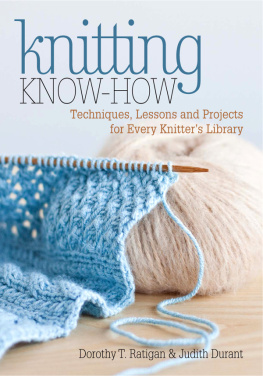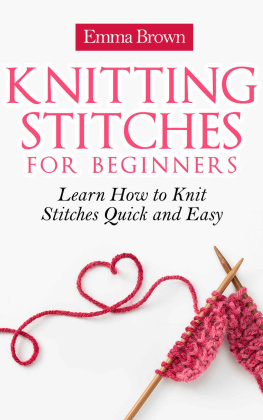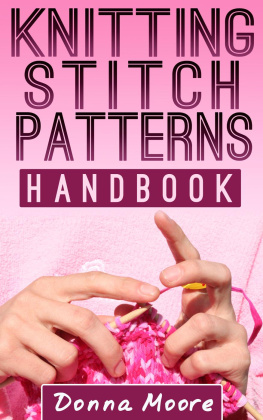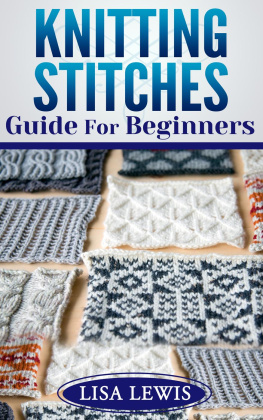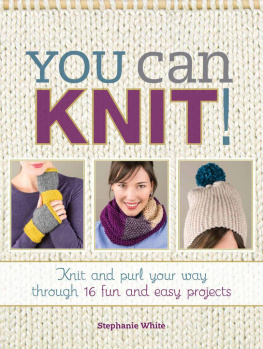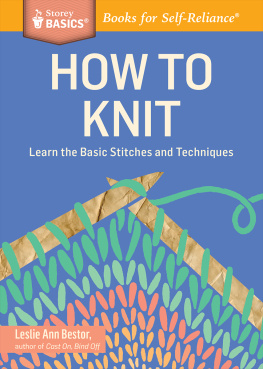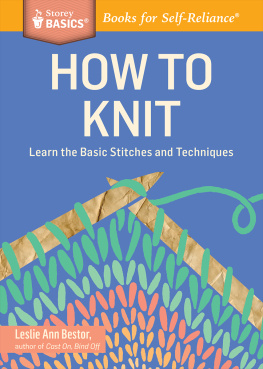Introduction
Dorothy and Judith met in the mid 1990s, when Judith was book editor at Interweave Press and Dorothy worked as a freelance technical editor for Interweaves knitting books. When Interweave Knits magazine was launched in 1996 with Judith as co-editor, Dorothy was a big part of the enterprise, both as technical editor and writer of the Beyond the Basics column. And, of course, we both contributed designs. Although Judith had been knitting for more than thirty years, it wasnt until knitting became a big part of her working life that she realized how much she didnt know.
Early on in the relationship, Judith saw the potential for gathering Dots knitting knowledge into a book to share with the world. The problem was finding the time to do it. While Dot had gathered an enormous amount of knitting know-how, it wasnt collected and filed in any particular order. Some things were written down; many things were not. No disrespect intended, but Judith likes to say that each bit of Dots information is stored on a sticky note in her brain; you never know which sticky note may fall out at any given time, and theres no way to easily access the one you want. We tried to start pulling it together a while back, but the need to work on other projects to pay the bills kept us from completing the task.
When F+W Media offered us a contract to do the book, we finally had no choice but to get to it. Judith caught Dots sticky notes as they dropped and made a list. We then added some of Judiths know-how to the list and came up with a master plan. As we worked through our outline, we remembered questions frequently asked by our students and made sure we answered every one of them. And as we worked through the chapters, we realized once again that knitting is an ever-evolving craft, and that there is almost always more than one way to solve a problem. So, rather than just present a dictionary of techniques, we chose to include only those that have worked best for us over the years. And weve done our best to describe why weve chosen these methods over others.
The book you hold in your hands represents a combined 100+ years of knitting and 50+ years of teaching experience. We dont know everything, but we do know a lot and hope that this know-how will help you become a better knitter and get even more pleasure than you already derive from our favorite craft.

Part I
Materials and Tools
Knitting has come a long way since its beginnings in the thirteenth century, and were lucky to have a huge variety of yarns, needles and other tools to work with.
discusses yarn in detail: what its made of, how its twisted, the various weights available and how its sold. Here youll learn how to read a yarn label and how to use that information to substitute one yarn for another. Also included is a chart for estimating how much yarn youll need for sweaters of various sizes, which is handy to know when you encounter a must-have yarn but have no idea what youll be knitting with it.
covers needles and needle sizes. There are choices to be made in materials, lengths and shapes: straight versus circular and even round versus square. Needle choice, like most things in knitting, is a matter of preference. But once youve tried various tools, you may find that with needles, you get what you pay for. If youre into knitting for the long haul, use the best tools you can afford.
In we discuss perhaps the most important tool for most knitters: the pattern. The most luscious cashmere yarn knitted on solid-gold needles will not yield a good result if you dont know how to follow the pattern. Youll learn about measurements, yarn requirements and required tools. We also provide a list of the most commonly used abbreviations in both text and chart form. We explain what those parentheses mean and how they differ from brackets, and if youve wondered what those asterisks are doing in most patterns, the answer is here.
1 Yarn
Y arn for knitting is spun (or not) from a veritable plethora of fibers: some are organic, some are synthetic and many are a blend of several materials. Some yarns are so fine they seem appropriate for cobwebs, while others are bulky enough to make into rugs. Yarns are packaged in several standard weights (with exceptions, of course) but the yardage varies greatly between the packages. This chapter will help you find your way through the yarn maze.
How Yarn Is Sold
Yarn for handknitting is most commonly sold in balls, skeins or hanks. Ribbon and other novelty yarns are often sold on spools. Yarn for machine knitting and weaving is usually sold on cones, though this yarn can also be used for handknitting. Its not clear to us why or how manufacturers choose which way to package their yarns for retail. You can find wool, cotton and other fibers presented in all these forms. Its interesting to note, though, that luxury yarns are almost always sold in hanks.

FINDING THE CENTER PULL
To find the end at the center of a ball or skein, insert your thumbs and index fingers into opposite sides so they meet in the center. You should feel that one side of the center hole is looser or more open than the other; the yarn end should reside in the more open part of the hole. Fish around until you feel the end and gently pull it from the center and out of the more open end. Its not always possible to find the very end, but you can usually locate the initial wraps and pull out a few yards to begin.
Balls of yarn are just what the name implies: The yarn is wound into a round shape that usually weighs 50 or 100 grams (1.75 or 3.5 ounces). Yarn wound into a ball is ready to knit, and most balls are wound so you can pull from both the center or the outside. This is handy when you want to knit with two strands held together.

A ball of yarn


